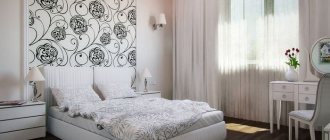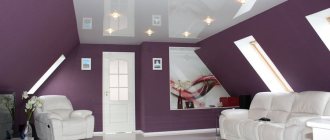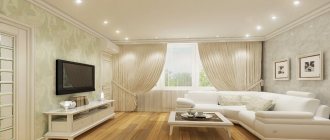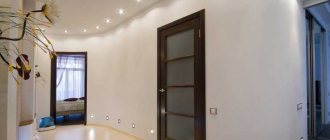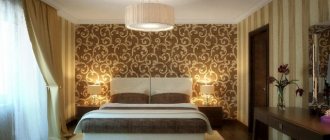Apartments with low ceilings are not that rare even in modern residential complexes. Traditionally, ceilings with a height of 2.4–2.5 m are considered the minimum acceptable for comfortable living. Very often, apartment owners in standard buildings receive exactly this option.
Correctly selected lighting will help to visually raise the ceilings and expand the space, creating a cohesive, complete design of the room. Experts advise paying attention to three key points:
- selection of lamp shapes and materials suitable for each specific case;
- selection of the correct direction of light;
- a competent combination of light sources and their attachment to the ceiling.
Peculiarities
A stylish, beautiful chandelier is undoubtedly the dream of many. However, low ceilings significantly narrow the choice.
When installing a lighting system, you should act with extreme caution, since if you do not know some design rules, you can make the room gloomy, depressive and mundane.
Experienced designers give some simple recommendations.
- Extended pendants are not suitable in this case; the closer the panel with lamps is to the ceiling, the better, only then will the light fully illuminate the living room. To enhance the desired effect, choose stretch fabrics and paints with a reflective effect.
- Buy a chandelier that will be fixed directly to the ceiling, in this way you will save space.
- If possible, combine different lighting sources in the room - it is advisable to complement the central chandelier with wall sconces; as an alternative, you can install lighting along the entire perimeter of the plasterboard box. In combination with the main lamp, such a solution will be quite effective.
If desired, you can make parallel lighting on the floor - this technique will allow you to extend the length.
- Give preference to spotlights evenly distributed throughout the room - this option is not only additional, but often the main one, while an abundance of small lamps can easily replace a chandelier.
- Avoid models with shades of dark colors; preference should be given to equipment that can transmit light in all directions.
What inexpensive chandeliers can be
The range of ceiling chandeliers is diverse and differs by several criteria. One of these is pricing policy. There is absolutely no need to spend exorbitant amounts of money, since the electrical appliance market has a large number of stylish and multifunctional ceiling lamps for little money. These include compact light sources, most suitable for low ceilings.
Here are a few examples of chandeliers for rooms with low ceiling heights:
- Chandelier with shades directed in different directions. An excellent option for suspended ceilings, since the device is made on a metal base and is intended for installation under the ceiling.
- A lamp with movable spots, made in a minimalist style. Very easy to use and install.
- Compact devices mounted on a hook tied to a chain decorated with textile materials. The low price is due to the use of budget materials. However, chandeliers retain their aesthetics and durability.
- LED chandeliers are characterized by an unusual design and increased durability of light sources. A good mid-budget device.
- A lamp in the form of an inverted plate, mounted on a rod. Made from inexpensive materials, which results in low cost. This shape ensures dispersion throughout the room, saving usable space.
Of course, these are not all the possible budget options available on the market. Select lamps yourself, be sure to focus on the manufacturer - beware of cheap fakes and do not forget that for the price of a Chinese product it is impossible to buy an original Italian chandelier. Make sure you have a quality certificate. Otherwise, such a purchase promises nothing but trouble.
Suitable options
Let's take a closer look at the various options for chandeliers that can be used to decorate a room with low ceilings:
- On the bar. These products may differ in the number and direction of the rods, as well as the length of the center console. This design ensures bright lighting. It is advisable to choose chandeliers whose shades are directed up, down and to the sides.
- Cascade chandeliers. Products are allowed in rooms with low ceilings only if the length of the hanging parts is short, the design contains many light elements, and the panel itself is wide. The models are compact and therefore do not overload the space.
- Crystal. These are luxurious and rich chandeliers that invariably give the room an expensive look. This option is optimal for living rooms decorated in baroque, rococo or classic style. It is advisable to have as many light bulbs as possible - then the reflected light will create a beneficial lighting effect in the room.
However, try to purchase a similar model that does not hang too far from the ceiling.
- Horn chandeliers. Such designs can be used when the suspended part is low and the lampshades are located as close to the ceiling as possible. When buying a chandelier, you should choose models that diffuse light efficiently and are optimally open.
LED models in high-tech interiors can have the most intricate configurations; they take up very little space, but at the same time become a real decoration of the room.
A win-win option would be flat ceiling lamps, which are placed almost under the ceiling. As a rule, they look like a large light element made of translucent material, with 2 to 8 light bulbs underneath it.
The only drawback of such lamps is the simplicity of the design, so this solution is suitable only for ultra-modern styles (minimalism or hi-tech).
Low ceiling - which chandelier might be suitable
A large and bright classic chandelier will look chic almost anywhere, with the exception of rooms with low ceilings. Designing here is not so easy. You need to remember a number of rules and recommendations, failure to comply with which will lead to negative consequences: the room will become even more squat, gloomy and even depressing.
Try to choose compact electrical appliances, avoiding the purchase of oblong lamps. To maintain balance and spaciousness in the room, consider the following:
- There is no need to take oblong lamps with decorations that emphasize the lowness of the ceiling and in some cases interfere with movement around the room.
- If only a chandelier is used for lighting, then choose models with several bulbs to illuminate the entire room.
- For lovers of the most compact lamps, we recommend paying attention to spotlights with a glossy ceiling coating, which allows you to visually expand the space and reflect light in different directions.
- If the room has suspended polyvinyl chloride ceilings, then consider some safety issues. It is important to select light sources that will ensure minimal heating of the canvas, and also to calculate the required distance between them. In addition, all light bulbs should be directed from the ceiling down and to the sides.
More about varieties
Chandeliers and pendants
Pendant lights are ideal for creating a relaxing and homely atmosphere by combining light and shade. This is a classic of the genre. If you want to decorate a small living room in a classic style, then you will probably choose a traditional chandelier. It is well known that chandeliers really help make a room more elegant.
They become the centerpiece that, like a sparkling stone, attracts attention and decorates the room. Chandeliers can change the entire look of a room by providing elegant, soft lighting.
It is believed that for a room of standard rectangular proportions, the best solution is to place the chandelier in the center of the room.
But if the room is long and narrow, then two identical chandeliers, respectively located along the ceiling of the hall, will create a very good aesthetic effect.
Some rules for choosing chandeliers for low ceilings:
- Not all classic chandeliers look good in the interior of a room with low ceilings. Massive chandeliers with colorful bright shades will only emphasize the small size of the room.
- Colored lampshades let in little light, resulting in dim lighting in the room. It is better to use matte white or transparent shades.
- It is also worth paying attention to the orientation of the lampshades. They should be directed upward towards the ceiling, then the reflected light will be scattered throughout the entire volume of the room.
- For a room with very low ceilings, you can use chandeliers and pendants with special devices that allow you to change the height of the pendant.
- The correct choice of suspension point is also of great importance. Ceiling chandeliers for low ceilings should be located in places where there is no possibility of touching them, for example, above a kitchen table, bar or sink, dining table or even a nightstand.
Ceiling lamps
They take up little space on the ceiling and are easy to attach, making them ideal for rooms with low ceilings. Stylish plastic lampshades are the most budget option. For their production, heat-resistant plastic is used, which does not change shape under the influence of high temperatures, and also does not emit harmful substances.
The classic material for making ceiling lamps is glass. Glass shades have the greatest variety of shapes, which explains their widespread use in design. Stained glass lampshades made of multi-colored glass have an unusual appearance. They are able to give the room a special charm and envelop it in romance.
There are also wooden lampshades on sale, which create unique light and shade and allow you to realize the most unexpected design ideas.
Fluorescent lamps
These lamps are very efficient compared to incandescent lamps. A fluorescent lamp consists of a phosphor-coated glass tube, a small amount of an inert gas (usually argon or krypton), mercury and a set of electrodes.
Contact points on the outside of the tube transfer electricity to the lamp.
Fluorescent lamps are 2-4 times more efficient than incandescent lamps when operating at wavelengths useful to humans. Thus, with the same effective luminous flux, they heat up less. The lamps themselves also last much longer - 10,000 to 20,000 hours versus 1,000 hours for a regular lamp.
Full size fluorescent lamps come in several shapes, including straight, U-shaped and circular configurations. The most common type is the straight fluorescent lamp, about 120 cm long.
In addition, lamps differ in so-called color temperatures: there can be options from warm (2700 K) to very cool (6500 K).
Cool white (4100 K) is the most common fluorescent lamp color. Neutral white (3500K) is becoming popular for office and home use.
Compact fluorescent lamps
These are miniature lamps that have the following characteristics:
- Standard thread on the base, so they can be installed on almost any lighting fixture;
- Available in a variety of sizes and shapes, they are used as energy-saving alternatives to incandescent lamps;
- The power is approximately 3-4 times greater than the power of incandescent lamps.
The disadvantage is the high cost, but they are very economical in the long run.
Spots
The time when it was fashionable to use a certain number of built-in lamps, placed at the same distance from each other, is long gone. Currently, spots are installed where they are needed.
Their number and position depend on several factors:
- Type of lighting. Each type has its own requirements. For general lighting you need less light, while for creating accents you need to look for spots with high light output. For example, spotlights can be an ideal solution for illuminating your favorite paintings and decorations;
- Luminous flux: some spots have a higher luminous output. Depending on the function you determine the required luminous flux;
- The angle at which the beam exits the light source. A spot with a small exit angle, for example, is better suited for accent lighting, while for general lighting, models with a large exit angle and, therefore, a wide beam of light are more suitable.
- The distance between the ceiling and the floor or other object that needs to be illuminated.
Built-in lights
At the moment this is one of the most popular types of lighting fixtures. The feeling of translucent light helps create the illusion of a higher ceiling, increasing the volume of a small room and giving the feeling of more space.
This lighting is quite versatile, but in areas with limited space and very low ceilings, it is better to use fully recessed fixtures (hallways, closets, bathrooms), while partially recessed fixtures look better in the kitchen, dining room, bedroom and foyer.
LED panels
It is a lightweight, portable and inexpensive lighting solution. LEDs not only do not take up room space, but are also exceptionally efficient, modern in design and easy to install. The panels provide even light with a complete absence of pulsation. This eliminates problems with hot spots and glare. Such panels are 5 times more powerful than conventional lamps, but consume significantly less electrical energy.
Only one remote control is required to switch multiple panels at the same time.
They can have different shapes, from round to square or rectangular. They are successfully used as an elegant design element. New LED technology allows the use of very thin flat panels, down to 1-1.5 cm. This means that they can be installed almost flush against ceilings, which was not possible in the past.
There are two varieties of LED flat panel fixtures: edge-lit and direct-lit.
They seem similar, but there are still some differences. The main difference is that direct backlit models have a light source located at the back of the panel. For this reason they are slightly thicker, usually between 8 and 10 cm.
Edge-lit models are much thinner, about 1cm thick, allowing for easy installation on a variety of surfaces.
Track lighting
This is a powerful tool for the designer and works best when creating lighting accents. The track is a channel on which lighting blocks are installed. It can be easily mounted on any surface.
The beauty of the track system is its versatility. The track design can be expanded or reconfigured, holders can be moved or added, their types can be changed, the tracks can be positioned in different directions, etc.
However, this flexibility can cause some problems.
To avoid glare and shadows, track lights should be aimed directly at the work surface. Additionally, a track system can look cluttered, especially in a room with a low ceiling.
However, when set up correctly, a well-planned track system can add a lot to the decor.
Choosing a central ceiling chandelier
If your living room or hall is decorated in a classic style, then you should definitely buy a central chandelier for lighting.
But not all classic chandeliers are friendly with low ceilings. Massive, too long and with a large amount of crystal will only emphasize the squatness of the room. Here's what the designers advise.
- Avoid ceiling models with suspensions.
- If you like dome-shaped or glass-like lampshades, then choose lamp models where these elements are small, but there are many of them. In this case, the lampshades must be turned upward.
For low ceilings, look for chandeliers where all the elements are attached to one rod without hangers and are fixed directly to the ceiling. Typically, the length of such models does not exceed 50 cm, which means that the owners will not touch their heads when walking.
The closer the lampshades are to the ceiling surface, the higher the room appears.
If the light from the lampshades goes upward, a calm, diffused lighting is created. Direct rays are reflected from the ceiling and, refracted many times, scatter throughout the room.
Important! In a large rectangular room, a chandelier turned upward will not be able to provide lighting around the edges of the room. To eliminate dark light spots, it is recommended to complement the central lamp with wall sconces, installing them in those areas where the main light does not reach.
Light sources for lighting fixtures
Several types of lamps can be used for chandeliers:
- Incandescent lamps – have a soft, warm light. The price of these products is very low. But they consume a lot of electricity, are very fragile, and tend to get very hot during operation. The service life of such lamps is relatively short.
- Advice: you should not use these light sources if the lamps are close to the ceiling surface. This is especially true in cases with suspended ceilings, or surfaces finished with materials that are susceptible to strong heat.
- Halogen lamps have a luminous flux close to natural light. Their service life is 2-4 thousand hours. But it largely depends on the stability of the voltage in the power grid.
- Fluorescent lamps are characterized by efficiency in terms of energy consumption. They do not heat up much during operation and will last a long time. They should only be used indoors - they are not resistant to temperature changes. In addition, due to the mercury content, such lamps must be specially disposed of. The service life of energy-saving light bulbs is significantly affected by the number of times they are turned on.
- LED light sources are currently the most acceptable in terms of energy consumption and durability. The design of these lamps is quite durable, they are produced in various shapes and sizes. In addition, a variety of colors are possible. They have a very long service life.
If you have a low ceiling, the type of lamps for the chandelier must be selected depending on the type of ceiling. Ceiling chandeliers for low ceilings are produced for lamps with a standard E27 socket, or with a reduced socket - E14.
Types of lamps used in chandeliers
There are four main types of light sources, but not all of them can be used for ceiling chandeliers:
- An incandescent lamp is a simple and common product with a low efficiency and low durability. The operation of such sources is not feasible from an economic point of view, since they consume large amounts of electricity. There is little positive about them - except that they are suitable for any room and, with the right choice of power, will provide soft and balanced lighting.
- Halogen sources are a modified version of incandescent lamps. More practical products of compact size with long service life and high light output. The electrical circuit must have a power supply.
- Energy saving devices (housekeepers) became popular at the beginning of the 21st century, when people started thinking about energy saving. Even more durable devices, the light output of which is significantly higher than conventional incandescent lamps.
- LED lamps are expensive, but the best of all the listed light sources. Today, devices are produced with standard bases suitable for ceiling, wall and table lamps.
Materials for ceiling lamps
Structurally, ceiling lighting fixtures consist of suspended fittings and lampshades with decor.
Lampshades and pendants can be made from:
- Glass;
- Plastics;
- Crystal;
- Ceramics;
- Porcelain;
- Fabrics.
Crystal and glass have high light reflectivity. Plastic can be used to make lampshades and decor of almost any shape.
Chandelier fittings are most often made of metal. It has good strength and excellent ductility, which makes it possible to make chandeliers of various shapes.
Mainly used:
- Painted steel;
- Stainless steel;
- Aluminum;
- Brass;
- Bronze.
For designer models, various types of wood, precious metals and stones are often used.
Crystal chandeliers for low rooms are a very good choice. They are produced in small dimensions, but the ability of crystal to refract and magnify light makes it possible to provide excellent illumination of the room. In addition, the aesthetic component of such lamps plays a significant role.
Thematic video
Rules for choosing chandeliers
Which chandeliers are better not to buy?
It is probably difficult to meet a person who would not strive to create maximum comfort and coziness in his home. Convenience directly depends not only on the furniture, curtains on the windows, little things located in different corners, but also on the type of lighting.
It plays one of the most important roles in the process of creating comfort. In this article we will look at the most suitable chandeliers for low ceilings. Photos and their characteristics will also be presented in this publication.
Styles
Depending on the style of the living room with low ceilings, chandeliers can be made in different design options.
- Classic - preference should be given to compact spider-type chandeliers or products with small shades in the form of flower buds.
- High-tech - this style involves laconic and primitive versions of chandeliers that will harmoniously complement the modern style of the room. Strict geometric lines do not clutter the interior and do not hide the height of the hall.
- Art Nouveau - this direction involves the use of refined artistic techniques that combine elegance and gloss. Most often, floral and floral motifs predominate here. Such equipment will make the living room more fresh and original.
- Fusion - chandeliers of non-traditional shapes are used here; in most cases they look unusual, for example, like a cluster of crystals, a starfish or glowing diodes.
- Eco- style - handmade products made from wood, threads and other natural materials are usually made in this style. Such lampshades are inexpensive and unique. Hand-made chandeliers attract attention and harmoniously emphasize the simplicity and laconicism of the room’s decoration.
- Provence - this decoration involves the installation of small lighting products with floral motifs. Compact models with decorations in the shape of flowers and buds are ideal here - they can become...
How to choose
A different approach is required when choosing lighting for individual rooms. In the living room it should be bright, in the bedroom it should be muted, allowing you to relax and unwind. Unfortunately, low ceiling heights lead to certain difficulties and make it impossible to install luxurious and lush chandeliers. General recommendations for choosing were described above, and then you can read tips on buying ceiling lamps for different rooms.
- A device consisting of several lampshades is suitable for the hall, but their number should be no more than five pieces. Lampshades of unusual shape will attract the attention of guests and increase the comfort of staying in the room. Living rooms with a classic interior can be illuminated with a spider chandelier or a carob-type product. To visually increase the ceiling, it is recommended to install devices above the table. Choose cool shades without massive decorative elements. Ideally, you need to complement the lighting with mirrored ceilings, which reflect the light from the chandelier and make the room much more spacious. Pay attention to the choice of light bulbs, which should provide the brightest possible lighting, making the room even more cozy.
- All of the above would be inappropriate for a bedroom where people rest and relax. Avoid saturated, bright light flow, focusing on simpler shapes.
Despite certain difficulties that arise when choosing lighting fixtures for rooms with low ceilings, following these recommendations you can independently choose the most suitable chandelier. A properly selected lamp will create the desired visual effects associated with increasing ceiling heights, expanding space and illuminating dark areas of the room.
Color solutions
The color of the ceiling chandelier will affect the visual size of the space: too bright shades will absorb light, so they will not be suitable for rooms with low ceilings. In order for the lamp shade to visually increase the height of the ceilings, it is necessary to choose matte white tones.
Such models perfectly transmit light and do not give shadows, as a result of which not only the ceiling, but also the maximum area of the room near the chandelier is illuminated.
It is better to choose light shades for ceiling lighting attributes for small rooms, since dark colors will narrow the upper part of the room, focusing attention on themselves.
Pastel-colored chandeliers expand the space, dissolving into it.
Stylish spotlights or LED panels will harmoniously fit into an apartment designed in high-tech, minimalism, or modern style. Such products will not crowd up a room with low ceilings, will provide soft light and can be mounted on suspended and suspended ceilings.
Types of chandeliers
There are four types of chandeliers that are suitable for rooms with low ceilings:
- Lamps mounted on a rod. You need to choose devices that are flat and horizontal in shape in order to illuminate the room to the maximum. The height of compact lamps on a rod is about 300 mm. The rod is the main element responsible for the reliability of the structure.
- Cascade lamps come in different heights, but for small-sized products its value can be 200 mm. They are characterized by a wide shape, and the presence of decorative elements does not make them bulky and heavy.
- I would especially like to highlight crystal chandeliers - large-sized lighting fixtures. Many people believe that their installation is only possible in spacious rooms with high ceilings. In practice, you can find compact crystal lamps that are suitable for rooms with low ceilings. Crystal inserts provide original refraction of light, which allows you to create beautiful and unusual lighting in the room.
- Horn chandeliers are classic ceiling lamps, consisting of several shades and installed without any suspensions. Chandeliers will save room space, especially since their height can be adjusted by changing the direction of the lampshades.
Shapes and sizes
The size of the ceiling chandelier will depend on the size of the room: it may have low ceilings, but a lot of space around it. In this case, wide lamps with small additional elements or patterns would be appropriate.
If the room has not only low ceilings, but also a small area, a compact attribute will be the best option. In addition to the size of the lampshades, it is also necessary to take into account their shape.
The shape of the lampshade plays an important role: a chandelier with a wide and elongated lampshade will lower the ceiling even more, while a narrow and long lampshade will give a different visual effect - everything will depend on where it is attached. Thus, a profitable option would be a pressed ceiling chandelier without additional decor or a strict elongated lamp with a mirror effect or metallic color.
Multi-level lighting - an option for the bedroom
Bedrooms don't need ceiling lighting at all.
These rooms are intended for relaxation, which means there is no need to hang a powerful chandelier. Soft twilight can be created with floor lamps, table lamps, and wall sconces. Lighting at different levels gives the interior intimacy and intimacy, because depending on the situation, you can turn off some of the lamps.
But what if there are wires sticking out from the floor slab? It’s simple: you remove the socket and hide the wires under a decorative PVC lampshade that matches the design with your ceiling material. Tension or hanging structures will completely hide the traces of the old chandelier inside.
Wall sconces can simultaneously create an intimate atmosphere and raise the height of the bedroom.
Avoid large, long chandeliers; if possible, hide the lamps inside the ceiling coverings - and your room will no longer seem squat.

